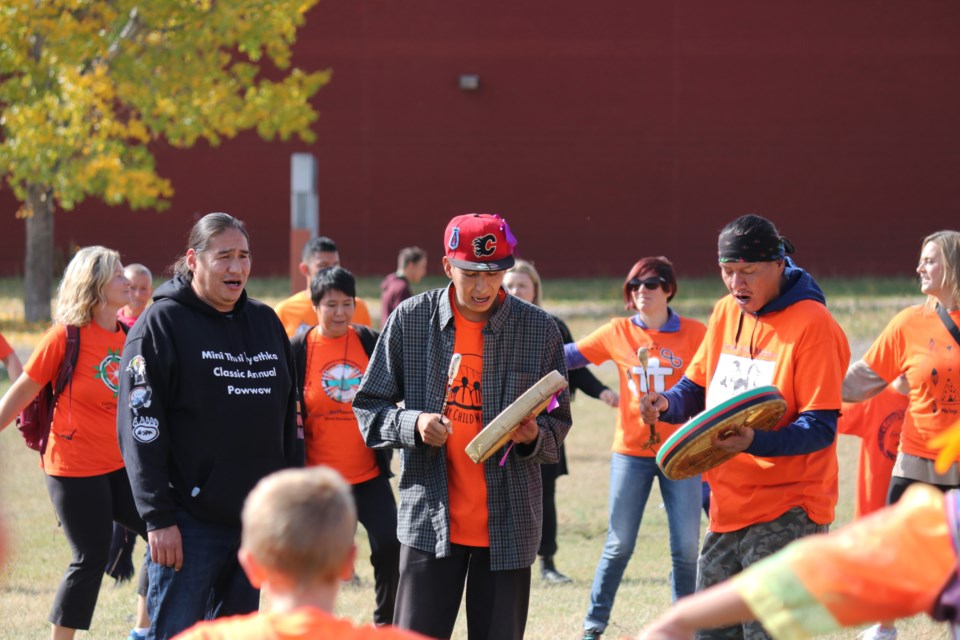STONEY NAKODA – A smile grew on Tina Fox’s face as she watched Indigenous and non-Indigenous people form a round dance – a traditional First Nations dance that brings people together to heal, honour and celebrate life – near the site of the former Morley Indian Residential School.
The Îyârhe (Stoney) Nakoda First Nation elder, 81, was resting her legs after finishing a 3.5-kilometre walk from McDougall Memorial United Church off Highway 1A to Morley United Church in Mînî Thnî in what was the community’s second annual Every Child Matters walk on the National Day for Truth and Reconciliation Friday (Sept. 30).
A survivor of the Morley school that closed in 1969, she was one of about 300 people to make the trek honouring other survivors, as well as those lost to the residential school system in Canada and their families.
“This is part of the healing process,” Fox said of the event. “To see that people are willing to hear us; to walk with us, as people.
“Truth is telling our stories – the ugly stories – for our community to hear and believe. And from there, we must heal both sides before we can get into reconciliation, but the work is starting to happen.”
Residential schools were established to educate and convert Indigenous youth, assimilating them into Canadian society. The first residential school opened in Brantford, Ont. in 1831 and by 1920, the federal government made attending residential school mandatory for all First Nations children ages seven to 16.
Fox spent 11 years in the Methodist United Church-run Morley residential school, where – like many of her schoolmates – she was emotionally, physically and spiritually abused. All influence of family, tradition and culture was stripped away.
The curriculum at the Morley Indian Residential School was typical of residential schools. For half a day, children were in school, while the other half was spent doing gender-based tasks.
Speaking Îethka (Stoney) was forbidden and considered a punishable offense.
“Anything cultural was considered the work of the devil,” said Fox. “You’d hear that for 10 years and then be returned home to your community totally changed.”
Fox was fortunate that her grandmother did not attend residential school and was able to pass along cultural teachings when she returned home, though she sometimes didn’t pay her grandmother much mind because she was taught to believe the Stoney culture was heathenistic.
“She was teaching us, but we were taught those things were the work of the devil, so we didn’t really listen to her,” said Fox.
“That’s what the schools did to us.”
Many of the social issues facing First Nations today can be traced back to residential schools and the harm First Nations children endured, she added.
“A lot of people turned to alcohol or drugs to deal with their traumas, and for generations, it’s had a big effect on our child-rearing.”
Residential schools have also led to an overall loss of identity after years of deprivation from their native language and culture.
Amanda Goodstoney, a family support worker with Stoney Family Resource Network, said her mother’s time in residential school resulted in a tough childhood. She’s since made it her life’s mission to break that cycle of trauma, which started with understanding what her mother endured and subsequently forgiving her for her actions.
“It’s my mission as somebody that understands the impacts of residential schools to stop the impacts of residential schools,” said Goodstoney in a small gathering at Wesley Elders Lodge Sept. 29. “While I may not have received it growing up … I’m able to be that mom that hugs their kids."
Fox’s son, Trent, who has a master’s degree in educational leadership and administration, said he believes a key part of breaking the continuous cycle of inter-generational trauma and reclaiming lost identity is developing new provincial curriculums to be inclusive of Indigenous peoples and address gaps in historical knowledge.
In the Truth and Reconciliation Commission (TRC) of Canada’s final report, the executive summary states education is the “key to reconciliation.”
No. 10 in the report’s 94 Calls to Action calls for “the federal government to draft new Aboriginal education legislation with the full participation and informed consent of Aboriginal peoples.”
The new legislation would include an obligation to provide adequate funding and incorporate principles such as ensuring educational achievement gaps are closed within one generation by providing adequate funding, developing culturally appropriate curriculums, and ensuring that Aboriginal languages are protected – including allowing credit courses in those languages.
Almost all provinces and territories have included the history of residential schools in their curriculums since the TRC's final report was released in 2015, but not all are mandatory, nor comprehensive.
“We have a situation right now where Canadian children are not really educated or socialized completely to understand the issues First Nations face,” said Trent. “And it perpetuates an ignorance of First Nations people in society.”
Closing that knowledge gap would be a meaningful step toward truth and reconciliation and should be one of the next calls to action addressed on a national level, he said, adding that all or more lesson plans should be offered in both English and native languages in Indigenous schools such as Nakoda Elementary School and Morley Community School in Mînî Thnî.
While there is still much work to do, Trent said it was encouraging to see so many people from neighbouring communities come together to pause and reflect on the impacts of residential schools during the Every Child Matters walk and its preceding and closing ceremonies.
“Just seeing all these people coming here and bringing their children to this event, dancing together … the winds have changed,” he said.
The Local Journalism Initiative is funded by the Government of Canada. The position covers Îyârhe (Stoney) Nakoda First Nation and Kananaskis Country.




